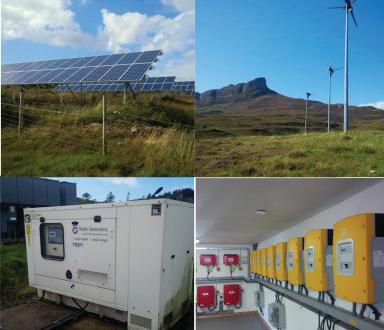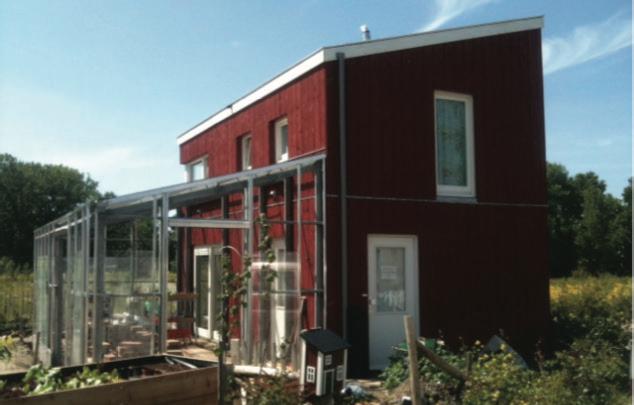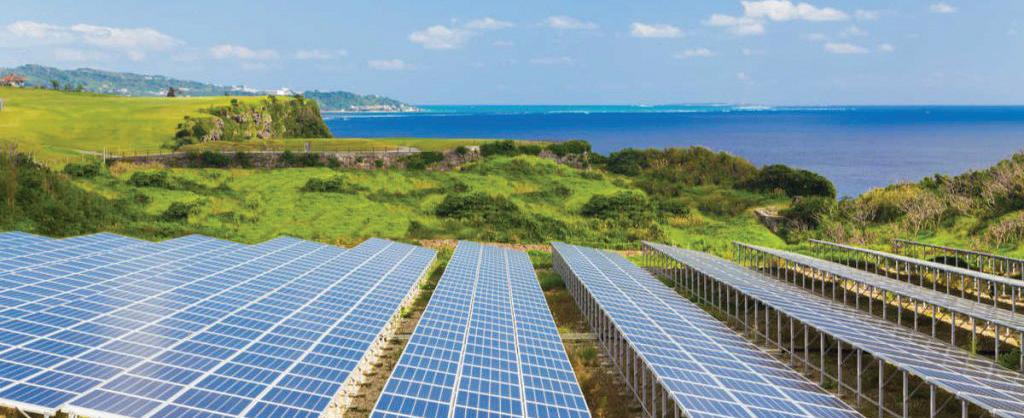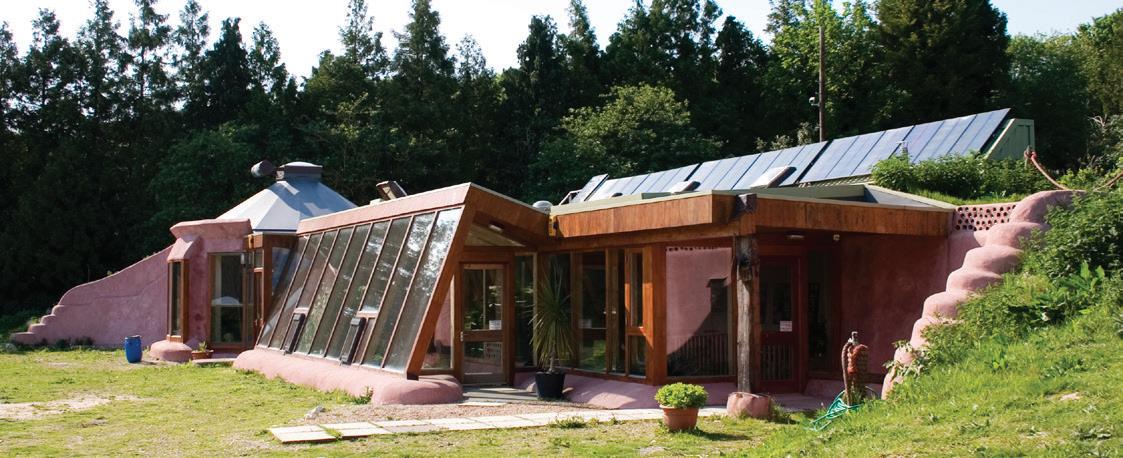
14 minute read
The Isle of Eigg p
Student:
María González Rodríguez De Biedma
Advertisement
Study:
The Isle of Eigg : A unique off-grid system
Keywords:
energy, sustainable community

above: Components of the off-grid system: PV arrays, wind turbines, battery bank, diesel generator, inverters system, 6 kW hydro turbine.
The island of Eigg is part of the Small Isles Archipelago in the Scottish Inner Hebrides, 12 miles away from the Scottish west coast. It only counts with 83 inhabitants which form a strongly linked community, that decided to make the first community buyout of an island in 1997. This new independence from certain government restraints allowed the community to propose an off-grid electric system to generate self-sufficient energy that would be respectful with the environment and would take advantage of the isle’ harsh weather conditions. As an exception to other off-grid systems proposed , this one is the first to rely on three renewable energy sources coming from the water, the air and the sun.
The system has been proved to have outstanding results as it generates energy and carefully distributes it to the population, generating a 24/7 electricity supply. The key in this system relies on understanding the natural conditions of the island, if there is a drier winter the system will take energy from the wind, if there isn’t enough sun, it will rely on rain and vice versa.
The system counts with an installed total capacity of 357kW, the battery bank system allows the energy storage and the inverter system controls the frequency and voltage of the grid depending on the energy loads and the demand. It is interesting to highlight that in order to avoid a saturation of the system all islanders have a limit use of 5kW each per day when normally the limit for commercial properties is of 10kW, however studies have proved that inhabitants consume just 20% of the total load allowed. The whole system is interconnected along the island through an 11km under-ground high voltage distribution system. This successfully implemented self-sufficient energy example makes this island as well more eco friendly as its CO2 emission per household in the island is 20% lower than the rest of the UK . Inhabitants remark that living in the island isn’t easy but it is understood as a lifestyle that is sustainable and in touch with nature. Not only their energy system is sustainable but also their economical activity which mainly relies on eco tourism, production of beautiful crafts and textiles or even a small local beer brewing.
Moreover, key to the functioning of this self-sufficient system is the strong sense of community that all inhabitants have. It is that spirit that allowed the island to bring big changes that have improved the live standards of the population, all islanders have a say in the island management decisions and that involves them in the cause, making it easier for everyone to respect the rules, understand the system and peacefully cohabit with their neighbors.
Nevertheless, as a matter of critique, the mobility of this island is poorly developed as it completely relies on the use of cars, not a very sustainable source.This matter could also be tackled in the future if the isle keeps evolving and increasing its population, in order to keep the island as a sustainable example for future self-sufficient projects.


Student:
Lauro Amadeo Lampis Temmink
Study:
Petit Place by RoosRos Architecten : The sustainable Dutch tiny house
Keywords:
building-scale
Petit Place is a Dutch initiative from RoosRos Architecten which aims to make fully self- suffi cient houses a livable concept. Apart from the notion of the environment, the houses are also supposed to be a solution to the growing problem of busier cities, increasingly expensive real estate, and the fact that many young people do not mind to live ‘small.’
Their concept house (left) was built in 2018 at the request of the municipality, and houses in its modest 40 m2: a bedroom, bathroom, kitchen, lounge area, and a terrace. The most evident feature is the exterior of the house, which is plated with solar panels that can generate up to three times the energy usage of its inhabitants, thereby actually supplying energy to the grid. There is hence no necessity for gas, and owners have the option of using a septic tank instead of water pipes, meaning the house can be erected anywhere and run completely independently of the city’s utility provisions. In addition to these features, the house is actually built from sustainable sources of materials, using glass from renowned manufacturer Velux and incorporating the world famous Iroko wood for its skeleton. Insulation is provided by ISO fl ax, a technology that uses old linen to give the house an incredibly high Rc value of above 7,0 m2K/W.
The agency offers people the option to design their own house, within a range of 25 to 1000 square feet, which they can then choose to build themselves or have it built by RoosRos – all at an average cost of only € 50 000, about a tenth of the average house price in Amsterdam! The picture bellow is the house that a friend of mine bought when she went to study in Rotterdam after boarding school. She bought a small plot of land in Wateringseveld, reachable from Rotterdam by bike, and bought the tiny house from RoosRos for about € 15 000 (it’s a smaller and less ‘luxurious’ one, although it has two fl oors). She calculated that costs of living in Rotterdam for a 3-year Bachelor would actually be more than this, and since the solar panels on her house generate too much power for her alone, she actually gets paid by the energy company for supplying electricity. But her design goes even further than the concept of Petit Place: she added a garden/greenhouse where she grows her own vegetables and fruits, and she has a few chickens for eggs. Therefore, all in all, she is extremely self-suffi cient regarding the house’s necessities, as well as fi nancially – and it is all good for the environment.


Student:
Anna Bundgaard Lassen
Study:
Changi Airport, Singapore : Waste management
Keywords:
waste, building scale
The Changi Airport located in Singapore is a central traveling hub, connecting various countries around the world, and while known for their extravagance they also have a big commitment and focus on sustainability. The Changi Airport Group (CAG) release sustainability reports that highlight their impact and also their contributions. Utilizing their own Changi Airport Sustainability Approach they focus on each level of their organizational hierarchy and how every individual can make contributions.
One particular area of improvement is their waste management, in 2015 “Water Resources Institute (WRI) ranked Singapore as one of the most waterstressed countries in the world.” (PUB), additionally, they were predicted to face water supply issues by 2040, therefore CAG made it part of their mission to create water through proper waste management systems.
How they do this is by converting food waste into water, the creation of innovative recycling machine and initiatives that utilize microbes to break down the food waste into clean usable water (Changi Airport Group), known as their Water Optimization Strategy. With millions of passengers passing through Changi every year, there is a lot of food waste to be utilized, and the CAG has capitalized on this factor to produce water. It functions with microbes which consume the food waste and, as a by-product, produce water. These “digester” machines can consume up to 20kg of food per hour, and the larger ones can eat the double. The testing period of this initiative was a 10 month period in which they were able to successfully convert 54,000kg of food waste into water. Currently, these digesters are available across Terminal 1 and 4 where 1,100kg of food is processed daily.
While having this strategy in-use, they also invest in the implementation of water-efficient components, the effective use of air condition and general water recycling. Between 2017 and 2018 the airport diverted 290 tons of food waste away from incineration. The CAG also engage with students and schools in order to teach about the importance of organizing trash and the potential harm it does.
Changi aims to bring a general awareness of waste to its visitors and therefore have a multitude of recycling bins and signs promoting the proper organization of trash and food waste.

Student:
Anna Bundgaard Lassen
Study:
Samso Island, Denmark : Energy self-sufficient
Keywords:
sustainable community, energy
Samsø is a small island in Denmark with approximately 4,000 inhabitants and each individual produces 12 ton less C02 when compared to the average Dane. In 1997 Samsø won a national wide competition due to their 10-year masterplan to become completely energy self sufficient. By 2007 the island succeeded ran on 100% renewable energy and was officially declared to one of the first islands to be energy self sufficient (Visit Samsø). A majority of the progress made was due to the involvement of the entire population to achieve this goal, and simultaneously strives for the further development of sustainability and the improvement of their existing methods.
Their electrical energy comes from a total of 21 turbines, 11 being onshore and the rest offshore, producing a total of 34 megawatts, whereas for their heating they utilize “ three straw-based district heating systems and one district heating plant” (Energiakademiet). Uniquely, 11 of the turbines being owned by local farmers and citizens, this came from the islands decision to approach their goal with a bottomup approach, looking for support from the entire population (EcoWatch) in order to give a voice to each individual and create an inclusive project.
When they achieved energy self-sufficiency rather than simply accepting their achievement, the Energy Academy was created to invest in their sustainable future. The Energy Academy is an organization that sets out goals and aids in the development of sustainability on Samsø. With the future goal of becoming fossil-fuel free by 2030, they launched their second phase known as Samsø 2.0 and so far, since 2014, the ferry that connects the island to mainland Denmark runs entirely on biogas, produced by their own biogas plant. This plant simultaneously also contributes to the management of waste produced by its citizens. The island has a main focus on the use of sustainable energy, and while having renewable sources implemented they also utilize low-energy architectural components, such as the insulation of their buildings and the optimal use of natural lighting.
The success of the island is entirely due to the community and local involvement, there were various local stakeholders such as the energy agency, development office and various other offices. They consider local ownership to be a fundamental success factor and strategy as, for example, 90% of the windmills are owned by local citizens (Energiakademiet).

Student:
Sophie Dany Marie-thé Monga
Study:
La Pointe Verte Community Garden, Montreal : The path to food autonomy
Keywords:
sustainable community, food
Montreal, in Canada, is involved since 1977 in the vegetablization of the city; they decided to dedicate 10% of the city to green spaces. Meanwhile, they realized a system of community gardens. In 2006, more than 1.5 % of the Montreal population were gardening in the municipal communal garden of Montreal, where there are 97 comminatory gardens with a total of 8200 parcels. The communal gardens system of Montreal is considered as the most accessible and best organized of Canada. However, due to the Montreal climate, only one harvest is possible each year.
La Pointe Verte garden: La Pointe Verte community garden in Pointe-Saint-Charles in Montreal has been operating since the 1980s and includes 52 garden plots and communal woodland. The overall budget is around 1000$ per year, collected with the 20$ member fees. Different studies estimate that nine squares meters could enable to feed one person during the year if the climate and the vegetables are appropriate.
However, the global production of the garden cannot be accurately predicted because it depends on the vegetables cultivated, the gardening method, the nutrition needs, and preferences of everyone. Besides, in the La Pointe Verte garden, each gardener is responsible for caring for his or her plot. local garden enables cities to be more autonomous. The alimentation becomes less and less dependent on other countries and no longer needs transportation, which pollutes a lot.
Moreover, it provides control over the food: you can produce high-quality vegetables with non-polluting techniques. As a result, the low-income population can have access to affordable healthy food. Besides the alimentation aspect, public gardens have positive social results. The population develops new technical skills, and the garden is a space for cultural and social exchange between residents.
Limits of a communal garden: Some hurdles need to be face before reaching the food autonomy of a city. According to the climate, you cannot garden every vegetable, and you might face some dry period during the year. Moreover, answering to the whole city food needs requires a considerable area which must be well located; if those areas are nearby polluting places, the soil might be contaminated, and it would impact the production.

Student:
Sophie Dany Marie-thé Monga
Study:
Ile Seguin, Boulogne Billancourt, France : Gaining autonomy in hot and cold water
Keywords:
water, city-scale
The Ile Seguin is a 74 hectares places located in the Ouest of Paris, within the city of Boulogne Billancourt. This place has been for decades vested with the Renault industry, but since the beginning of the 21st century, this place is being totally transformed into a new living place, with many innovations aiming to respect the environment and be as autonomous as possible.
Within this case study, we are going to focus on one innovation: the hot and cold-water autonomy through renewable energies.
The goal of this installation is to be as autonomous as possible in providing hot and cold water. In order to do so, the city implemented three systems, which, once associated, answered to 100% of both hot water and cold water needs of the city:
• Two geothermal heat pumps within the city. This pump answers to 80% of the city cold water needs and 35% of the hot water needs.
• They are cooling water by stocking ice and water from the Seine river. This system provides 20% of the cold water. • They are working with an incineration center, with the steam creating through the burn of wastes water can be heated. As a result, 65% of the hot water is ensured by this system.
To sum up, this whole system, by combining different tools, answer the needs of the city. As a result, the city is self- sufficient in this area.

Student:
Capucine Marie Verbrugge
Study:
Earthship Brighton : a self-sufficient building
Keywords:
building-scale, energy, water
An Earthship is a concept that was introduced in the 1970’s that promote homes built into the ground out of earth and recycled materials. Such materials vary from wood, rocks, waste tires, glass bottles and cans. The goal is to, by building such a structure, reduce the impact of these wastes on the environment. Earthships are self-sufficient homes, meaning that they function throughout renewable energy and nonpolluting sources to meet heating, cooling and power requirements. There are considered as “off-the-gridready” homes constructed to use resources such as
sunlight and rainwater.
A case study of an Earthship construction is the Earthship Brighton owned by a non-profit organization called Low Carbon Trust. It was established and designed by Mike Reynolds in 2005 in Stanmer Park, Brighton and was the first construction of this type built in England. The intentions behind this project were to provide a self-sufficient community center to meet local need, change constructions attitudes and spread environmental awareness.
Earthship Brighton is a passive solar earth shelter. Indeed, a passive solar shelter on the contrary of a solar heating building, does no require the use of mechanical and electrical devices. It is a way of placing windows, walls and floors to collect, store, reflect or distribute solar energy to either heat or cool of a building. The house uses four renewable technologies to meet the electricity and heating needs; photo-voltaic panels and a wind turbine for electricity, and solar thermal panels and a wood pellet stove for water heating.
The structure contains a system or rain harvesting. Rain harvesting is the recuperation of water from the sky for the site. Earthship Brighton is located in a region where it rains excessively, therefore, the structure can harvest around 50 000 Liters of water per year. This amount of water is equivalent to the annual consumption of water by one person. The rainwater accumulated flows for the roof through two filters to four underground tanks. The capacity of the tanks is enough to supply
Earthship Brighton for around two to three months.
Finally, there is a system of plant treat waste that was put in order to filter “grey water”, water from sinks and showers. In Earthship Brighton are plants of two botanical treatments cells to clean the water. They are placed next to south facing windows to maximize their natural filter process. The filtered water is then used for toilet purposes. Any remain of that water, commonly called “black water” is discharged from the home and placed in a settling tank before it is treated to go back in the nature.









